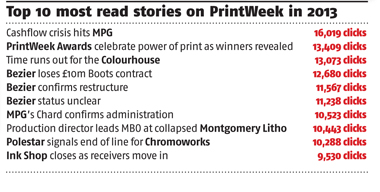Kodak exits Chapter 11
After going into Chapter 11 bankruptcy protection in January 2012, the photographic and imaging firm completed its successful emergence in September this year with chief executive Antonio Perez proclaiming “what’s next starts now”. The year began with Kodak receiving court approval for the $525m (£327m) sale of its digital imaging patents to a consortium, enabling the business to proceed with its exit strategy. Key to its emergence was the cash sale for $650m, in April, of its Document Imaging and Personalised Imaging businesses to UK Kodak Pension Plan (KPP), in a move that also helped solve its pension liability issue in the UK. The ‘new’ Kodak is focused on commercial imaging, with a large part of its operations made up of its commercial printing, digital printing and packaging operations. The firm is optimistic about its future performance, forecasting sales of $2.6bn next year.
Ipex bounces back for 2014 event
After the withdrawal last year of a host of major exhibitors from the 2014 event, including Xerox, Kodak and HP, the first half of this year showed no let-up for Ipex organiser, Informa, with the withdrawal in March of Canon and the event’s second largest exhibitor Ricoh, following suit in June. It followed the unveiling, in January of a refreshed focus, repositioning the event as a digital and cross-media show held over six days instead of eight. Other exhibitors rallied, however, with Konica Minolta, the show’s largest vendor reconfirming its commitment to the event along with Screen and Goss. The latter, a new name on the 42,000m2 floorplan, used the Ipex 2014 Open Day last month to announce its attendance at the show, which has now sold almost 80% of the available space. Event director Trevor Crawford was bullish on the show’s prospects, telling the industry: “I believe we’ve moved from being a trade show to being an event.”
MPG falls into administration
Ambitious, expanding book printing group MPG hit the buffers in 2013, in one of the year’s biggest stories. In May, just a year after agreeing to take over the Cambridge University Press (CUP) in-house printing operation in a deal that would have propelled sales to £28m, the group hit a cash crisis caused by over-running costs at the new plant it was setting up in Cambridge.
One worker told PrintWeek: “It’s not a year since CUP stated that the agreement with MPG would take us former employees into retirement. Well, it’s a very early one.”
The whole group was in limbo for several weeks, an attempt to salvage all or part of the business as a going concern failed and administrators from BDO were finally appointed at the end of June – more than a month after the company effectively ceased trading.
Other book printers have subsequently snapped up some of MPG’s state-of-the-art equipment, including CPI Group and St Ives Clays. Last week PrintWeek revealed that US-based book printer Bang Printing is buying the Timsons T-Print press from MPG’s King’s Lynn site, the biggest piece of remaining kit at the business.
Berforts and Butler Tanner & Dennis merger creates third biggest UK book printer
One way or another it was a significant year for UK book printing, with more major happenings in June when Berforts and Butler, Tanner & Dennis announced plans to merge, creating the UK’s third-biggest book printer with sales of more than £25m.
The creation of Berforts BT&D involved a share swap between BT&D owner Felix Dennis and Berforts majority shareholder Gerald White. Despite losses at BT&D, White said he was optimistic about the prospects for the combined entity once his business skills were added to the equation. “We’re going to turn it around,” he stated. “The deal has been done to make sure it doesn’t incur losses in the future.
“Felix has supported this through thick and thin. He is determined and I am determined that it will be there for the long term.”
Polestar confirms plans for mega web spend
After expanding with the pre-pack acquisition of Goodhead Group companies BGP and Stones the Printers at the end of 2012, in 2013 Polestar moved to revamp its web offset platform with plans for a £50m investment in new web presses from Goss International.
The deal, for a total of six presses including 96pp, 64pp and 16pp models, was announced in April. The first two presses to be installed, both 96pp, will also be the first modern web presses of that format in the country. Polestar said they would be up and running in the first half of 2014.
Speculation began immediately about where the new kit would be sited. Polestar chief executive Barry Hibbert said a new web offset ‘supersite’ next to its gravure facility wasn’t likely, saying: “We looked at it as an option, but we couldn’t make the numbers work in terms of payback.”
However, later in the year Polestar did submit plans for an extension to its Sheffield site, an option that had been on the drawing board since the facility’s inception. But as the year draws to a close there has still been no official confirmation of where the presses will be going.











